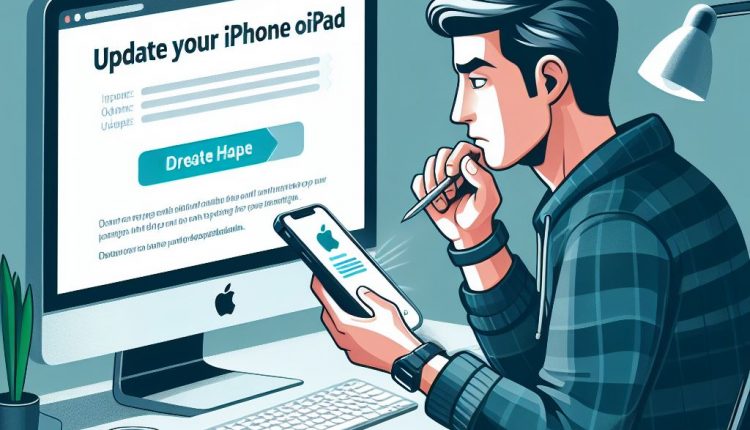Keeping your iPhone, iPad, or iPod touch updated with the latest version of iOS or iPadOS is important for getting new features and security updates. Upgrading wirelessly is the easiest way to update, but you can also use a Mac or PC if needed. This guide covers everything you need to know about how to update your iOS device.
Back Up Your Device Before Updating
Before updating it is essential to back up your iPhone or iPad either using iCloud or iTunes on a computer. Backups ensure you have a copy of your data like photos, messages, etc. in case any issues arise during the update.
To backup to iCloud:
- Go to Settings > [your name] > iCloud
- Enable iCloud Backup
- Tap Back Up Now to manually start a backup
For iTunes backups on a Mac with macOS Catalina or later or Windows PC, connect your device and:
- Open Finder or iTunes
- Select your device
- Click Back Up Now
On a Mac with macOS Mojave or earlier:
- Open iTunes
- Select your device
- Click Back Up Now
Updating Your iPhone or iPad Wirelessly
Once backed up, updating wirelessly through Settings is simple. You will need:
✅ A strong Wi-Fi connection
✅ 50% or higher battery life
✅ Enough storage space on your device
Then to download and install:
- Go to Settings > General > Software Update
- Tap Download and Install
- Enter your Passcode if prompted
- Follow the on-screen instructions
The update typically takes 10-15 minutes though larger updates may take longer. Your device will automatically reboot and relaunch once finished.
📝 If you encounter any alert messages or issues updating wirelessly, try the tips in the sections below.
Dealing with Wireless Update Alerts
If you are connected to a VPN or proxy server, disconnect to allow your device to contact Apple’s update servers. Airplane mode can also sometimes resolve connectivity problems temporarily.
You may also see an alert that means:
- The update failed to download or failed verification after downloading. Try again on a better Wi-Fi network.
- There’s not enough free space for the update. Follow the storage space steps next.
Managing Storage Space During Update
If your device storage space is insufficient for the update, you may be prompted to temporarily remove apps to make room for updating and download them again after. Tap Continue to allow this or:
- Manually delete unused content — Settings > General > [iPhone | iPad] Storage > [select app] — to free up space instead of removing apps
- Cancel the update and enable app offloading to automatically remove unused apps if needed later
Once the update completes, any removed apps will be automatically reinstalled.
Customizing Automatic Update Installation
To enable automatic updating on your device:
- Go to Settings > General> Software Update
- Turn on Automatic Updates
- Toggle Download iOS updates
- Toggle Install iOS updates
With this enabled, update downloads will start automatically overnight if your device is charging and connected to Wi-Fi. Daily notification reminders will appear prompting you to install system updates as well.
You can adjust the timing of automatic installs by tapping Customize Automatic Updates further below in Software Update settings.
Some updates still require manual installation when first released. You’ll get a notification when that is the case.
Installing Rapid Security Responses
Apple issues Rapid Security Responses in between major iOS updates to quickly patch vulnerabilities. To enable their automatic wireless installation:
- Go to Settings > General > Software Update
- Turn on Security Responses & System Files
This allows security fixes to install just like regular iOS updates. If issues arise or battery drain increases after one installs, you can remove it by:
- Going to Settings > General > About
- Tapping your iOS Version
- Scrolling down and tapping Remove Security Update
This uninstalls the latest Rapid Security Response while preserving the rest of the iOS update it arrived in.
Why Software Upgrades Are Important
Upgrading to the latest iOS or iPadOS version provides:
- New features: Like Dark Mode, widgets, App Library etc. Some features only work on select iPhone/iPad models.
- Security updates: Critical patches for vulnerabilities to keep your device safe.
- Bug fixes: Squashes errors, glitches and other software issues.
Not all features may be available on all devices or in all regions. Battery life and performance can also be impacted by usage patterns and network conditions after an update.
For additional troubleshooting, Apple’s Support Communities provide peer assistance while Support agents can provide personalized help if issues persist.
Keeping your iPhone, iPad, or iPod touch’s software up to date ensures you get the latest features, security enhancements, and overall improvements to the iOS or iPadOS experience. Follow the steps in this guide to easily update wirelessly or through a computer.
Let me know if you need any clarification or have additional questions!


